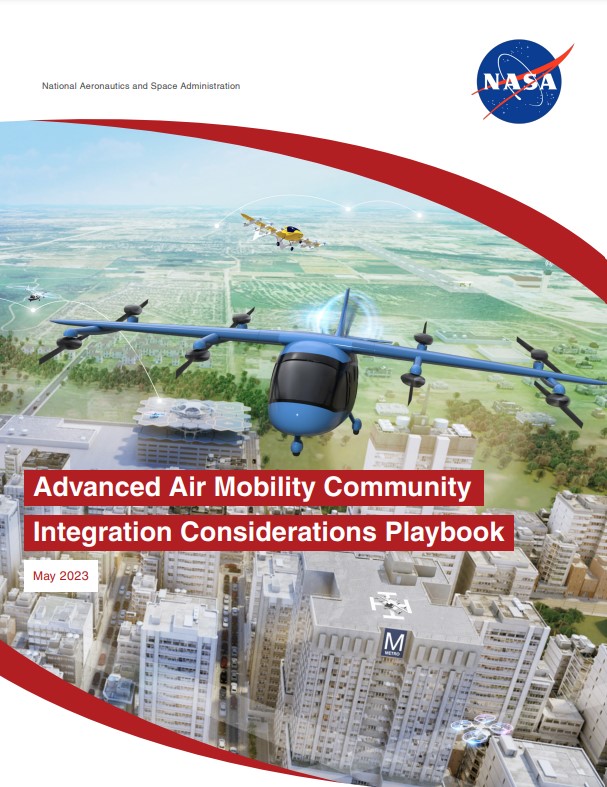Read “Advanced Air Mobility Community Integration Considerations Playbook” by Adam Cohen, Shahab Hasan, Nancy L Mendonca, and Yolanka Wulff
This AAM Community Integration Considerations Playbook, from here on referred to as the “considerations playbook,” aims to provide an overview of planning considerations and the subject matter experts’ thinking relevant to local and regional AAM planning activities. It is intended to have a narrow scope and focus on considerations that could be initiated within the United States at the local and regional level. In the years to come, AAM will evolve requiring additional research, planning, and policymaking. The purpose of this document is to serve as a practical resource that can help provide initial information to inform local, regional, state, and tribal planning for AAM.
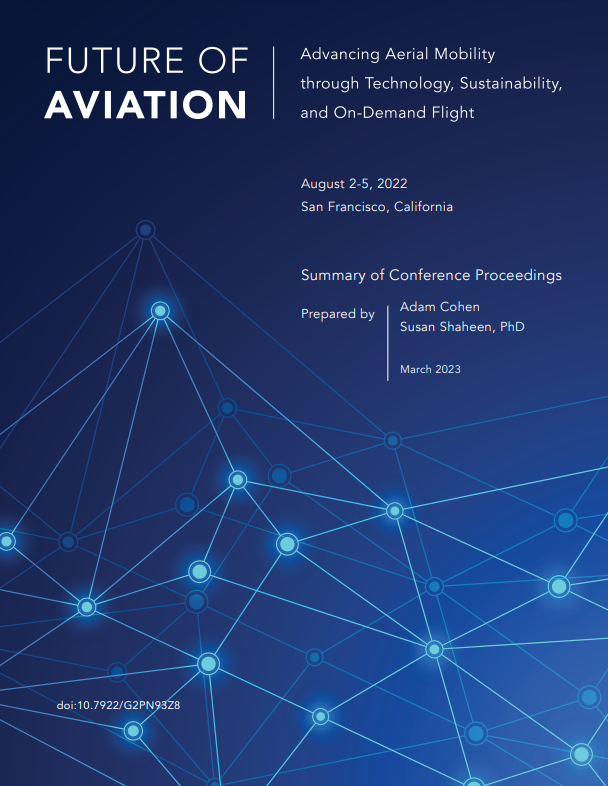
Read “Future of Aviation: Advancing Aerial Mobility through Technology, Sustainability, and On-Demand Flight” by Adam Cohen and Susan Shaheen
Advanced air mobility (AAM) is a broad concept enabling consumers access to air mobility, cargo and package delivery, healthcare applications, and emergency services through an integrated and connected multimodal transportation network. AAM includes local use cases of about a 50-mile radius in rural or urban areas and intraregional use cases of up to approximately 500 miles that occur within or between urban and rural areas. The Future of Aviation Conference: Advancing Aerial Mobility through Technology, Sustainability, and On-Demand Flight was held in person at the San Francisco International Airport from August 2 to 5, 2022. The conference commenced with an AAM 101 workshop hosted by the Community Air Mobility Initiative (CAMI) on August 2nd. The full conference program began on August 3rd. This event advanced key research and policy discussions around environmental impacts, safety, security, equity, multimodal integration, and the role of government.

Read “Urban Air Mobility: History, Ecosystem, Market Potential, and Challenges” by Adam Cohen, Susan Shaheen, and Emily Farrar
Since the early 20th century, inventors have conceptualized “plane cars” and other urban aerial transportation. Emerging innovations in electrification, automation, and other technologies are enabling new opportunities for on-demand air mobility, business models, and aircraft design. Urban air mobility (UAM) envisions a safe, sustainable, affordable, and accessible air transportation system for passenger mobility, goods delivery, and emergency services within or traversing metropolitan areas. This research employed a multi-method approach comprised of 106 interviews with thought leaders and two stakeholder workshops to construct the history, ecosystem, state of the industry, and potential evolution of UAM. The history, current developments, and anticipated milestones of UAM can be classified into six phases: 1) “flying car” concepts from the early 1910s to 1950s, 2) early UAM operations using scheduled helicopter services from the 1950s to 1980s, 3) re-emergence of on-demand services starting in the 2010s, 4) corridor services using vertical take-off and landing (VTOL) envisioned for the 2020s, 5) hub and spoke services, and 6) point-to-point services. In the future, UAM could face several barriers to growth and mainstreaming, such as the existing regulatory environment; community acceptance; and concerns about safety, noise, social equity, and environmental impacts. UAM also could be limited by infrastructure and airspace management needs, as well as business model constraints. The paper concludes with recommendations for future research on sustainability, social and economic impacts, airspace integration, and other topics.

Read “The Potential Societal Barriers of Urban Air Mobility (UAM)” by Susan Shaheen, Adam Cohen, and Emily Farrar
Community perceptions of users and non-users could present challenges to adoption and mainstreaming of urban air mobility (UAM). A few potential concerns include noise and visual pollution; privacy (particularly for flights over sensitive land uses); social equity; and safety and security. This exploratory study reports the findings of two focus groups in Los Angeles and Washington D.C., and a five-city general population survey consisting of 1,700 respondents in Houston, Los Angeles, New York, San Francisco, and Washington, D.C. (approximately 350 respondents per city). The focus groups and survey asked questions about perceptions of UAM from the user and non-user perspectives; willingness to use UAM, pay and share flight in a small aircraft with other passengers, and fly in various weather conditions; trust in aircraft automation and electrification; and other social and environmental concerns. The study concludes that familiarity with UAM is a notable factor influencing public perception and willingness to fly, suggesting that education and outreach will play an important role in the growth of UAM.
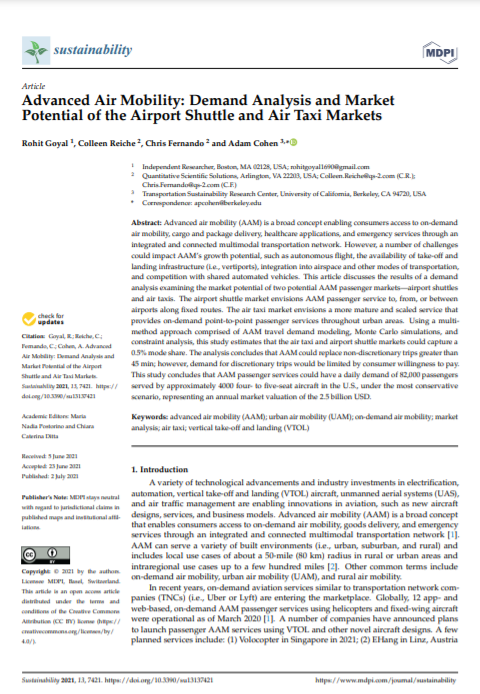
Read “Advanced Air Mobility: Demand Analysis and Market Potential of the Airport Shuttle and Air Taxi Markets” by Rohit Goyal, Colleen Reiche, Chris Fernando, and Adam Cohen
Advanced air mobility (AAM) is a broad concept enabling consumers access to on-demand air mobility, cargo and package delivery, healthcare applications, and emergency services through an integrated and connected multimodal transportation network. However, a number of challenges could impact AAM’s growth potential, such as autonomous flight, the availability of take-off and landing infrastructure (i.e., vertiports), integration into airspace and other modes of transportation, and competition with shared automated vehicles. This article discusses the results of a demand analysis examining the market potential of two potential AAM passenger markets—airport shuttles and air taxis. The airport shuttle market envisions AAM passenger service to, from, or between airports along fixed routes. The air taxi market envisions a more mature and scaled service that provides on-demand point-to-point passenger services throughout urban areas. Using a multi-method approach comprised of AAM travel demand modeling, Monte Carlo simulations, and constraint analysis, this study estimates that the air taxi and airport shuttle markets could capture a 0.5% mode share. The analysis concludes that AAM could replace non-discretionary trips greater than 45 min; however, demand for discretionary trips would be limited by consumer willingness to pay. This study concludes that AAM passenger services could have a daily demand of 82,000 passengers served by approximately 4000 four- to five-seat aircraft in the U.S., under the most conservative scenario, representing an annual market valuation of 2.5 billion USD.
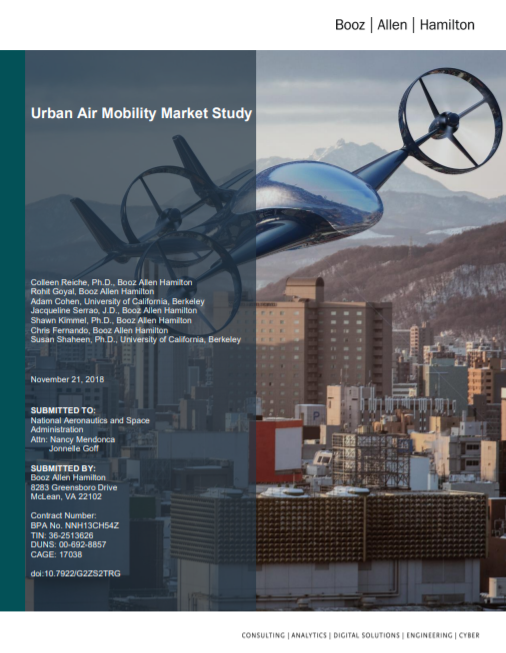
Read “Urban Air Mobility Market Study” by Colleen Reiche, Rohit Goyal, and Adam Cohen
The Booz Allen Team explored market size and potential barriers to Urban Air Mobility (UAM) by focusing on three potential markets – Airport Shuttle, Air Taxi, and Air Ambulance. We found that the Airport Shuttle and Air Taxi markets are viable, with a significant total available market value in the U.S. of $500 billion, for a fully unconstrained scenario. In this unconstrained best-case scenario, passengers would have the ability to access and fly a UAM at any time, from any location to any destination, without being hindered by constraints such as weather, infrastructure, or traffic volume. Significant legal and regulatory, weather, certification, public perception, and infrastructure constraints exist, which reduce the market potential for these applications to only about 0.5% of the total available market, or $2.5 billion, in the near term. However, we determined that these constraints can be addressed through ongoing intra-governmental partnerships, government and industry collaboration, strong industry commitment, and existing legal and regulatory enablers. We found that the Air Ambulance market is not a viable market if served by electric vertical takeoff and landing (eVTOL) vehicles due to technology constraints but may potentially be viable if a hybrid VTOL aircraft are utilized.
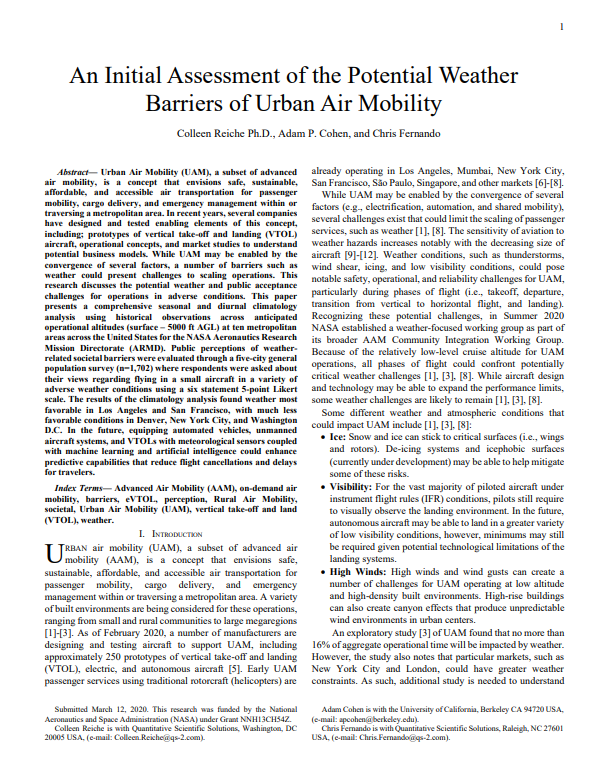
Read “An Initial Assessment of the Potential Weather Barriers of Urban Air Mobility” by Colleen Reiche, Adam Cohen, and Chris Fernando
Urban Air Mobility (UAM), a subset of advanced air mobility, is a concept that envisions safe, sustainable, affordable, and accessible air transportation for passenger mobility, cargo delivery, and emergency management within or traversing a metropolitan area. In recent years, several companies have designed and tested enabling elements of this concept, including; prototypes of vertical take-off and landing (VTOL) aircraft, operational concepts, and market studies to understand potential business models. While UAM may be enabled by the convergence of several factors, a number of barriers such as weather could present challenges to scaling operations. This research discusses the potential weather and public acceptance challenges for operations in adverse conditions. This paper presents a comprehensive seasonal and diurnal climatology analysis using historical observations across anticipated operational altitudes (surface –5000 ft AGL) at ten metropolitan areas across the United States for the NASA Aeronautics Research Mission Directorate (ARMD). Public perceptions of weather-related societal barriers were evaluated through a five-city general population survey (n=1,702) where respondents were asked about their views regarding flying in a small aircraft in a variety of adverse weather conditions using a six statement 5-point Likert scale. The results of the climatology analysis found weather most favorable in Los Angeles and San Francisco, with much less favorable conditions in Denver, New York City, and Washington D.C. In the future, equipping automated vehicles, unmanned aircraft systems, and VTOLs with meteorological sensors coupled with machine learning and artificial intelligence could enhance predictive capabilities that reduce flight cancellations and delays for travelers.
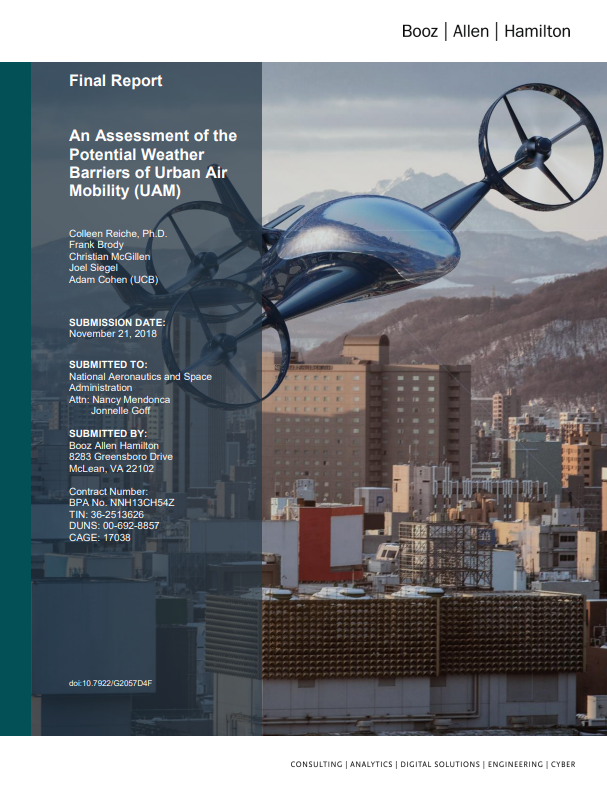
Read “An Assessment of the Potential Weather Barriers of Urban Air Mobility (UAM)” by Colleen Reichie, PhD, Frank Brody, Christian McGillen, Joel Siegel, and Adam Cohen
Urban Air Mobility (UAM), a subset of advanced air mobility,is a concept that envisions safe, sustainable,affordable, and accessible air transportation for passenger mobility, cargo delivery, and emergency management within or traversing a metropolitan area. In recent years, several companies have designed and tested enabling elements of this concept, including; prototypes of vertical take-off and landing (VTOL) aircraft, operational concepts, and market studies to understand potential business models. While UAM may be enabled by the convergence of several factors, a number of barriers such as weather could present challenges to scaling operations.This research discusses the potential weather challenges for operations in adverse conditions.This report presents a comprehensive seasonal and diurnal climatology analysis using historical observations across anticipated operational altitudes (surface –5000 ft AGL) at ten metropolitan areas across the United States for the NASA Aeronautics Research Mission Directorate (ARMD).
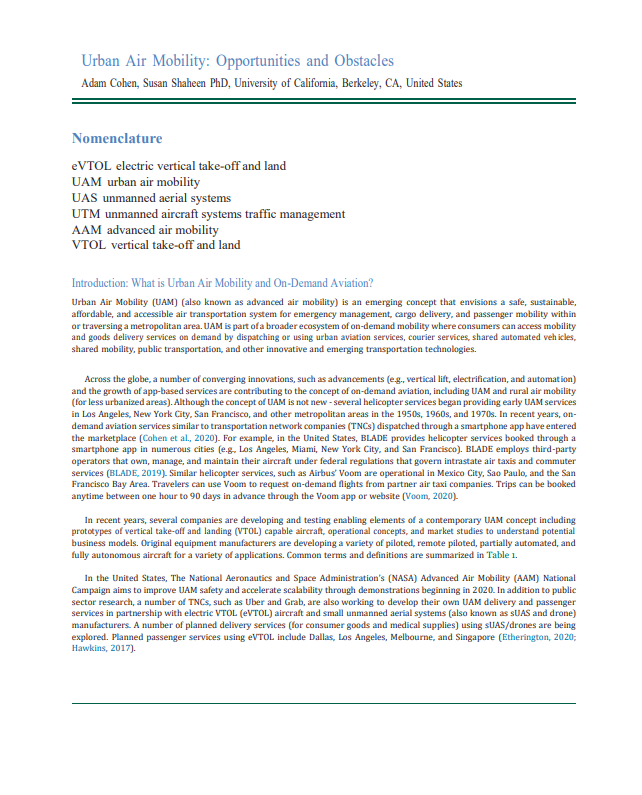
Read “Urban Air Mobility: Opportunities and Challenges” by Adam Cohen and Susan Shaheen
Urban Air Mobility (UAM, also known as advanced air mobility) is an emerging concept that envisions a safe, sustainable, affordable, and accessible air transportation system for emergency management, cargo delivery, and passenger mobility within or traversing a metropolitan area. While numerous societal concerns have been raised about these approaches (e.g., privacy, safety, security, social equity), on-demand aviation has the potential to provide options for emergency services, goods delivery, and passenger mobility in urban and rural areas using small piloted and autonomous aircraft. This chapter provides a short overview of developments in on-demand aviation and a discussion of the potential impacts and challenges of UAM on communities. Potential challenges include safety, financial, and community acceptance, among others. Research that seeks to understand the potential societal barriers can help to identify challenges and mitigate potential UAM concerns. Research on the potential impacts of UAM, coupled with thoughtful planning and implementation, are needed to balance commercial interests, technology innovation, and the public good.

Read “A Legal and Regulatory Assessment of Urban Air Mobility (UAM)” by Jacqueline Serrao, Sarah Nilsson, and Shawn Kimmel
This paper reviews existing and anticipated legal and regulatory requirements for urban air mobility. It also discusses variations in requirements observed at the local and state levels of government; international developments; certification issues; and opportunities to address legal barriers and gaps.

Read “Reimagining the Future of Transportation with Personal Flight: Preparing and Planning for Urban Air Mobility” by Adam Cohen, Justin Guan, Matthew Beamer, Ryan Dittoe, and Seyedmirsajad Mokhtarimousavi
On January 12, 2020, the Transportation Research Board (TRB) of the National Academies hosted a workshop titled “Reimagining the Future of Transportation with Personal Flight: Preparing and Planning for Urban Air Mobility” at the 99th Annual Meeting of the Transportation Research Board in Washington, D.C. This paper summarizes key findings from the workshop, such as the role of safety, community acceptance, multimodal vertiport infrastructure, and automation shaping the future of UAM. This paper discusses thoughts on the evolution of UAM; policy challenges and needs; barriers to community acceptance; potential strategies for overcoming key challenges; and research needs for maximizing opportunities and mitigating key risks to prepare for UAM.

